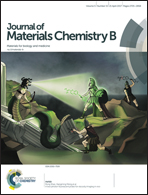Facile preparation of pH/reduction dual-responsive prodrug nanohydrogels for tumor-specific intracellular triggered release with enhanced anticancer efficiency†
Abstract
A facile approach has been developed to prepare novel biocompatible and biodegradable pH/reduction dual-responsive oxidized alginate-doxorubicin (mPEG-OAL–DOX/Cy) prodrug nanohydrogels for tumor-specific intracellular triggered release of anticancer drug doxorubicin (DOX), by conjugating DOX via acid-labile Schiff base linkage into the alginate nanohydrogels crosslinked with bioreducible disulfide bonds. The uniform prodrug nanohydrogels, which were prepared with the oxidized alginate (OAL) with an oxidation degree of 20.0%, PEGylation degree of 7.5 mol%, and crosslinking degree of 94.0%, showed a favorable DOX content (22.7 ± 0.4%) with an average hydrodynamic diameter of about 170 nm. They released DOX rapidly in lower pH media mimicking the tumor microenvironment with a cumulative DOX release rate of 58.4% within 58 h with a sustained release behavior in long term release resulting from their nanohydrogel–micelle transformation, while the premature leakage under the simulated physiological conditions was only 15.5%. The MTT assay demonstrated that the mPEG-OAL–DOX/Cy prodrug nanohydrogels exhibited enhanced inhibitory efficiency against SKOV3 cells, in comparison with free DOX.



 Please wait while we load your content...
Please wait while we load your content...